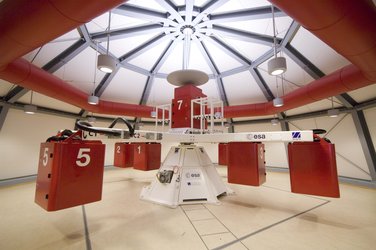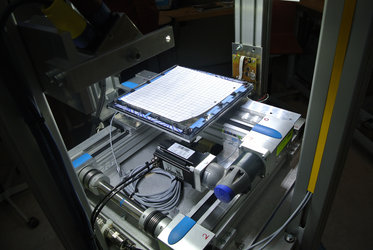Meet the teams: GAGa DropT (2012)
A team of university students has been selected to develop and perform their microgravity experiment during ESA's ‘Drop Your Thesis!' 2012 campaign. Here is an introduction to the team.
![]()
![]()
Granular Anisotropic Gases in Drop Tower Experiments
![]()
![]()
| University | Otto-von-Guericke University Magdeburg |
| Endorsing professor |
Ralf Stannarius Otto-von-Guericke University Magdeburg |
| Assistant scientist | Torsten Trittel |
| Team | Kirsten Harth, Sandra Wegner, Kathrin May |

The GAGa DropT team is composed of three PhD students studying at Otto-von-Guericke University Magdeburg (Germany). They have investigated the behaviour of granular anisotropic gases in microgravity.
Granular gases are loose, agitated ensembles of grains found in places ranging from sandstorms, to avalanches, to the rings of Saturn and the asteroid belt.
The study of granular gases began as an engineering topic before moving to geoscience, and finally to contemporary physics. Despite the ubiquity of granular gases, there exists no comprehensive dynamic theory of their behaviour. Studies are typically restricted to computer simulations with spherical balls. A few simulations of non-spherical grains have been published, mainly concerning granular cooling or two-dimensional systems. Particularly for granular gases that are weakly excited, experiments are difficult to perform under the Earth’s normal gravity. Keeping a granular material in suspension in air requires a strong excitement strength (in order to counteract gravity). To study weakly excited granular gases in three dimensions, microgravity is required.

The team will experimentally investigate a regime that is outside the scope of current computer simulations and experiments: a weakly excited anisotropic granular gas in three dimensions. The grains will be cylindrical, not spherical, and the data obtained will not be one or two dimensional, but fully three dimensional.
Three cubic shaking containers will be partially filled with ensembles of rods of equal dimensions but different colours. Voice coil actuators typically used in speaker systems will be used to weakly agitate the grains at specific frequencies and amplitudes. Each shaker will be videotaped from two angles which will later facilitate the three dimensional reconstruction of position and velocity data (both linear and angular).
The team will make use of the ZARM drop tower’s catapult mode where the capsule is accelerated rapidly at the base of the drop tower, and allowed to rise and fall within the tower; the catapult mode gives the team approximately 9.3 seconds of microgravity. The system will reach dynamic equilibrium within 3 seconds.
After the experiments, videos of the granular gas will be analysed frame-by-frame by a computer algorithm, determining the position and orientation of the rods in three dimensions. Resolved over time, this data can obtain important characteristics of the granular gas as a whole, such as: rod density profiles over time and space; linear and angular velocity distributions; energy distributions and average energy in the ensemble. The research is considered at the forefront of granulate science research.
Read more about this experiment on the ERASMUS Experiment Archive.






